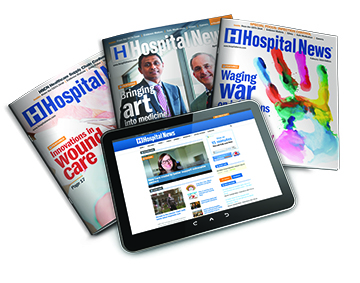By Dr. Sonny Kohli
A routine day in the clinic can quickly turn atypical when a patient presents with something unfamiliar: A middle-aged male with a palate lesion; superficial veins in the neck of an 18-year-old; an obese, heavy smoker with non-itchy vesicular rash.
You can make a diagnosis, but you’re thinking that a quick check-in with colleagues could provide valuable insight. That said, with the press of patients waiting to be seen, and schedules that no longer allow for even hallway chats, curbside consults often go by the wayside. However, in the digital environment, there’s no need for a doctor’s lounge. With physician crowdsourcing platforms, you only need a laptop or smartphone to touch base with colleagues.
As an internist and critical care specialist, I first engaged in crowdsourced medicine in late 2015 through Medscape Consult, the peer-to-peer digital platform offered to physicians. In one of my first posts, I uploaded a photo of a 72-year-old woman who presented with right hand pain, swelling, and low grade fever that had developed over the course of one day. Her WBC was 14, but the uric acid level was normal and there was no bacteria upon aspiration. The community jumped in with discussion and suggestions — from infection to CPPD (calcium pyrophosphate dehydrate) crystal deposition disease — (it turned out to be severe osteoarthritis and pseudo gout). It was exciting, and I was sold on the value of virtual conversations.
I started out as a case contributor for Consult, posting interesting cases from my practice to prompt learning and discussion and went on to become an editor, weighing in with advice on critical care cases. But I still continue to reach out for help from colleagues.
I have communicated with physicians across specialties and around the world, viewed discussions with fellow clinicians, and shared cases, asked questions and discussed best practices. The volume of responses has continued to increase as physicians – including perhaps some previous skeptics – have given crowdsourcing a try and now recognize the value of connecting with colleagues in a quick, meaningful, and occasionally amusing way.
In one discussion, a physician shared a case of a patient who developed a strange blemish at the injection site during a routine blood draw, which quickly spread up her arm. Her post generated responses from colleagues in more than 50 countries and in 13 specialties, with answers ranging from phlebitis to a fungal infection. The response that proved correct was a case of sun sensitivity, exacerbated by the presence of limes – most likely from drinking a margarita in the sun. Another physician volunteered that she had also seen it happen with martinis.
In all, the few minutes I spend in virtual conversations have enhanced my professional life as well as my practice. That said, in Canada, the impact of physician crowdsourcing may go beyond individual practice to potentially helping to alleviate the current challenges to the healthcare system.
For physicians understandably concerned about health privacy, credible crowdsourcing platforms safeguard the identities and ensure ultimate privacy of patient information. Medscape Consult protects patients by requiring that all identifying information is removed from text and images. Comments and posts are moderated 24/7. Consult is accessible only by registered physicians.
Can crowdsourcing help ease healthcare stressors?
As Canadian physicians, we find ourselves inundated during the practice day, with patient and staff demands, bureaucracy, and the push of a patient load and extended wait times brought on by physician shortages. While the issue demands broad-scale, focused solutions, crowdsourcing may help by potentially streamlining diagnosis and supporting a treatment rationale that helps avoid unnecessary and costly interventions.
Additionally, virtual knowledge sharing can help close the knowledge gap with colleagues in rural and remote settings, potentially enhancing the quality and efficiency of care. Doctors in resource-poor settings can upload images, post medical lab image results, and hear from pathologists and other specialists. Crowdsourcing can help narrow the divide between ‘our world and theirs’ as it creates a true global medical community – a global medical village, if you like.
A crowdsourcing platform is accessible to any physician with a smartphone – regardless of health care or payer system. One day after Medscape Consult launched, a South American paediatrician posted that he was seeing a spike in babies born with microcephaly in areas that had recently seen a wave of Zika infections. He asked about a possible connection to the Zika virus weeks prior to health organizations’ alerts about the epidemic.
Similarly, doctors in more remote areas may support a diagnosis in a patient exhibiting symptoms that are rarely seen in a more developed region. One of my earlier posts, which included an image upload of bloodwork, concerned a previously healthy 43-year-old male with confusion and vomiting recently arrived to Canada from Jamaica. It prompted a lively discussion. Most physicians favored pursuing a possible hematological malignancy, such as ALL or CLL. But with the help of a physician offering valuable — and ultimately accurate — context regarding the etiology, we tested for a retrovirus. The helpful physician happened to be from the Caribbean, where HTLV1 prevalence is high.
Real-life doctors
Physicians may hate to admit it, but the isolation of medical practice can take a quiet toll. Even in a group practice, the tempo of the work day leaves little time for curbsides. We are sequestered in our offices, regardless of setting. For me, crowdsourcing has mitigated that isolation, and cultivated a friendly professional community.
There is a remarkable heterogeneity in posting, and a range of personalities. Some physicians hew to their training and find it difficult to admit what they don’t know. Others are surprisingly honest, arriving to Consult with a “what the heck is this?” honesty. Sometimes the answers elude most of us, and sometimes the solution comes from a far reaching place, where what is rare for you is not for someone else. The contact may be virtual, but we get to know each other.
And, returning to some recent cases, the range and depth are as diverse as the crowdsourcing medical community itself. For example, the suggestions regarding the palate lesion ranged from possible primary syphilis to HPV squamous cell carcinoma or a salivary gland tumor (which it was). The majority of physicians thought the non-vesicular rash was Sweet’s Syndrome, but virtually all recommended a biopsy (which found bulbous vasculitis), and the young man with superficial neck veins? A bit of head-scratcher, with colleagues volunteering it was a possible symptom of leukemia, or a contusion from choking games or autoerotic asphyxiation. The poster returned to say that in fact it was dye from the patient’s clothing that had rubbed off. You could hear the collective “well, what do you know?” from the community and a few commenters noting they would remember the discussion and, if presented with a similar symptom, rule out the clothing dye first.
Dr. Sonny Kohli, MD FRCPC, is an Internal Medicine/Critical Care specialist in Ontario Canada, Assistant Adjunct Clinical Professor at McMaster University, Co-founder and Chief Medical Officer of Cloud Dx, and a 2017 recipient of the ‘Bold, Epic, Innovator Award’ in the Qualcomm Tricorder XPRIZE competition .




